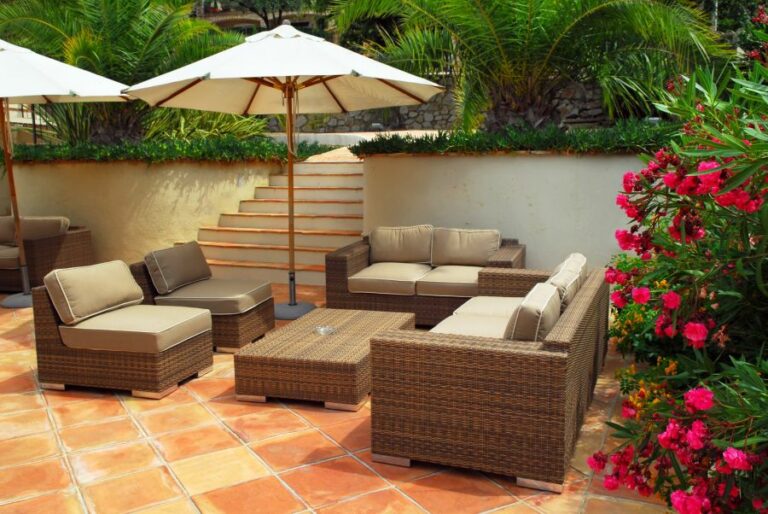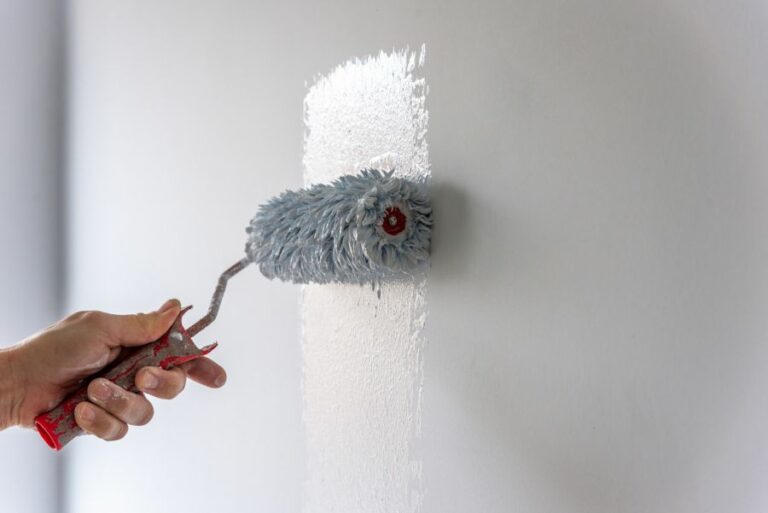How To Paint Outdoor Metal Railings. What Pros Say
Painting outdoor metal railings can be challenging, but worry not; we’ve got you covered! You can transform those rusty railings into an eye-catching feature with the right techniques and tips. Read on to discover the steps in this process, ensuring a smooth, durable finish to make your outdoor space stand out.
How to paint outdoor metal railings:
To paint outdoor metal railings, first clean them with a detergent solution and scrub brush, then rinse and let dry. Remove rust and loose paint with a wire brush, and sand the surface using 80-grit followed by 120-grit sandpaper. Optionally, apply a rust converter. Prime the railings with a metal-specific primer, then paint using either oil-based or acrylic paint suitable for outdoor use. Apply multiple thin coats and maintain with occasional touch-ups.

Discover the secrets to successfully painting outdoor metal railings and give them a fresh, durable finish to withstand the elements. Keep reading for valuable tips, recommended materials, and a step-by-step guide to ensure your railing makeover is both beautiful and long-lasting.
Contents
- 1 Guide to Painting Metal Railings for Outdoor Use
- 2 What Type of Paint Should be Applied on Exterior Metal Railings?
- 3 What is the process for preparing metal railings to be painted?
- 3.1 • Introduction
- 3.2 • Evaluating the Condition of the Railings
- 3.3 • Tools and Materials
- 3.4 • Step 1: Removing Rust and Loose Paint
- 3.5 • Step 2: Cleaning and De-Greasing the Surface
- 3.6 • Step 3: Sanding and Smoothing the Surface
- 3.7 • Step 4: Masking and Protecting Surrounding Areas
- 3.8 • Step 5: Applying Primer and Paint
- 3.9 • Step 6: Cleanup and Final Touches
- 3.10 • Conclusion
- 4 What is the Optimal Paint Finish for Metal Railing Surfaces?
- 5 Is Priming Necessary Before Painting Metal Surfaces?
Guide to Painting Metal Railings for Outdoor Use
Painting outdoor metal railings can give a fresh, new look to your home while also protecting the metal from rust and wear. Follow this comprehensive guide to achieve a professional finish and keep your metal railings in top shape.
• Materials and Tools You’ll Need
Before starting any project, it’s essential to gather all the required materials and tools. Here’s a list of what you need:
- Wire brush
- Sandpaper (80-grit and 120-grit)
- Bucket and detergent
- Scrub brush
- Garden hose or pressure washer
- Rust converter (optional)
- Metal primer
- Paint suitable for metal surfaces (oil-based or acrylic)
- Paintbrushes, foam rollers, or paint sprayer
- Painter’s tape
- Drop cloths
- Gloves
- Safety glasses
• Step 1: Prepare the Metal Railings
The first step to ensure a professional finish is to properly prepare the metal railings for painting. This involves cleaning, removing rust, and sanding the surface.
– Remove Dirt and Grime
Begin by cleaning the railings with a detergent solution and a scrub brush. A simple solution of dish soap and water should be sufficient for this purpose. Ensure that all dirt and grime are removed, as they can prevent the paint from adhering to the metal surface properly.
Rinse thoroughly with a garden hose or pressure washer and let the railings dry completely.
– Remove Rust and Loose Paint
Inspect the railings for any signs of rust or loose paint. Use the wire brush to remove rust and flaking paint from the metal surface. Don’t forget to wear safety glasses in this step, as debris may fly into your eyes.
– Sand the Metal Surface
Use 80-grit sandpaper to sand any rough spots, edges, or remaining paint. This helps to create a smooth surface for the primer and paint. After sanding with 80-grit sandpaper, switch to 120-grit sandpaper for a finer finish.
Make sure to sand the entire railing, even the parts that aren’t visibly affected by rust or paint flaking, to ensure proper adhesion.
• Step 2: Apply Rust Converter (Optional)
If your railings have any remaining rust, applying a rust converter can help neutralize and prevent further corrosion. Rust converters work by chemically reacting with rust to form an inert, stable layer that can be painted over. Follow the manufacturer’s instructions and let it dry as recommended.
• Step 3: Prime the Metal Railings
A high-quality metal primer will help the paint adhere to the surface and prevent rust. Choose a primer that is compatible with your chosen paint and specifically designed for metal surfaces.
Apply the primer evenly to the railings using a brush, foam roller, or paint sprayer. Allow the primer to dry according to the manufacturer’s instructions.
• Step 4: Paint the Metal Railings
Choose either oil-based or acrylic paint for metal surfaces, ensuring it is suitable for outdoor use. Apply the paint with a brush, foam roller, or paint sprayer, depending on your preference and the intricacy of your railings.
Apply multiple thin coats, allowing each coat to dry before applying the next, as recommended by the manufacturer. This will provide better coverage and durability.
• Step 5: Clean-Up and Maintenance
Remove painter’s tape and drop cloths, being careful not to let any paint chips or residue contaminate your surroundings. Cleaning up your tools immediately after use allows for easier maintenance and longevity.
Regularly inspect your railings for signs of wear, rust, or paint chipping. Maintain the protective coating with occasional touch-ups or repainting as needed.
• Conclusion
Taking the time to properly prepare, prime, and paint your metal railings outdoors will not only improve their appearance but also protect them from rust and wear.
Following this step-by-step guide can help you achieve a professional finish and prolong the life of your railings, saving time and money in the long run.
Step | Description |
|---|---|
1 | Prepare the area by laying down a drop cloth or protective covering to catch debris, paint drips, and dust. |
2 | Ensure the metal railings are free from rust, dirt, and loose paint by using a wire brush or sandpaper to scrape off any imperfections. |
3 | Wipe down the metal railings with a damp cloth or sponge to remove any remaining dirt, dust, or debris, and allow the railings to dry completely. |
4 | Apply a rust-inhibiting primer to the metal railings using a paintbrush or roller, allowing it to dry according to the manufacturer’s instructions. |
5 | Select an appropriate outdoor metal paint, preferably one that is resistant to rust formation and has UV protection. |
6 | Apply the first coat of paint using a paintbrush or roller and ensure even coverage. Allow the paint to dry according to the manufacturer’s instructions. |
7 | Apply a second coat of paint, allowing it to dry completely. |
8 | Inspect the railings for any spots that may have been missed or need touch-ups. Apply additional paint if necessary. |
9 | Remove the drop cloth or protective covering and clean any tools or brushes used in the process. Enjoy your freshly painted outdoor metal railings! |
What Type of Paint Should be Applied on Exterior Metal Railings?
Exterior metal railings not only add support and safety to various outdoor spaces but also contribute to the overall aesthetic of a property. Choosing the right type of paint is an essential part of maintaining and enhancing the appearance of these functional and decorative features.
Selecting the correct paint not only safeguards the metal from harsh weather conditions and corrosion but also significantly impacts the durability and longevity of the railing.
• Why Choose the Right Paint for Metal Railings
To fully understand the importance of choosing the right paint, it helps to recognize the challenges that exterior metal railings face. These challenges include:
- Weather exposure: Railings are continually exposed to the elements, such as rain, snow, sun, and wind, and need to withstand these conditions without faltering in terms of stability and appearance.
- Corrosion: Metal surfaces are susceptible to rust and corrosion if not adequately protected, which leads to weakened railings and an unsightly appearance.
- Aesthetic impact: The paint on metal railings directly affects the curb appeal of a property, making it crucial to select a paint that maintains its color and finish for an extended period.
Keeping these factors in mind, let’s explore the best paint options for exterior metal railings.
• Top Choices for Paint for Exterior Metal Railings
1. Acrylic Latex Paint
Acrylic latex paint is a popular choice for exterior metal railings due to its durability, resistance to fading, and ease of application. This type of paint forms a flexible, protective layer that adheres well to metal surfaces, allowing it to expand and contract with temperature fluctuations.
Acrylic latex paint also offers excellent UV resistance and is known to withstand harsh weather conditions effectively.
2. Direct-to-Metal (DTM) Paint
Direct-to-metal (DTM) paint is a high-performance paint designed specifically for metal surfaces. It offers excellent adhesion, durability, and corrosion resistance. As a single-component paint, it eliminates the need for a separate primer, making the painting process more straightforward and time-effective.
DTM paints are also available in acrylic and alkyd versions, providing options based on specific requirements and preferences.
3. Oil-Based Paint (Alkyd)
Oil-based or alkyd paint is another common choice for exterior metal railings, primarily due to its robust adhesion and rust-inhibiting properties. Alkyd paint provides a hard, durable finish that resists chipping and peeling, making it suitable for outdoor applications.
However, oil-based paint is less environmentally friendly and may take longer to dry compared to acrylic latex and DTM paints.
• Preparing and Painting the Metal Railings
Before applying paint, proper preparation of the metal railings is crucial for a successful and lasting paint job. Here are the recommended steps for preparing and painting exterior metal railings:
1. Cleaning the Surface
Start by removing any dirt, dust, or debris from the railing surface using a stiff-bristled brush or power washer. Use a water and mild detergent solution to clean the surface thoroughly, ensuring that all grease and grime are removed. Rinse with clean water and allow the railings to dry completely.
2. Removing Existing Paint, Rust, and Corrosion
Inspect the railing for any loose paint, rust, or corrosion. Use a wire brush or sandpaper to remove these imperfections and achieve a smooth and clean surface. For heavily rusted areas or stubborn paint, a paint remover may be necessary.
3. Priming the Surface
Depending on the type of paint you choose, a metal-specific primer may be required to ensure proper adhesion and corrosion protection. Apply the primer according to the manufacturer’s instructions and allow it to dry completely before proceeding.
4. Painting the Railings
Using a high-quality paintbrush or paint sprayer, apply the paint in thin, even coats. Allow the paint to dry between coats, following the drying time recommended by the manufacturer. Applying multiple thin coats will result in a more durable and longer-lasting finish.
5. Sealing the Paint (Optional)
To increase the paint’s durability further, consider applying a clear sealer designed for metal surfaces after the final coat of paint has dried. This step will provide additional protection against weather exposure and UV rays.
• In Conclusion
Properly maintained exterior metal railings not only provide essential safety and support to various outdoor spaces but also enhance a property’s aesthetic appeal.
Choosing the right type of paint and following the recommended preparation and application steps will ensure long-lasting and visually appealing results.
Paint Type | Description | Benefits |
|---|---|---|
Acrylic Latex Paint | Water-based paint that is made up of a combination of acrylic and latex. It is commonly used for exterior metal surfaces. | Easy to clean, environmentally friendly, resistant to cracking and peeling, dries quickly. |
Oil-Based Paint | A paint that uses a drying oil, such as linseed oil, as the binder. Often used for exterior metal surfaces due to its durability. | High durability, long-lasting finish, resistant to water, stains, and abrasion. |
Direct-to-Metal (DTM) Paint | A particular type of paint designed specifically for painting metal surfaces without needing a primer. It contains anti-corrosive agents that help prevent rust. | Adheres well to metal surfaces, protects against rust and corrosion, time-saving due to no primer needed, available in various finishes. |
What is the process for preparing metal railings to be painted?
• Introduction
Painting metal railings is an effective way to protect them from corrosion and prolong their lifespan. However, proper preparation is essential for achieving a long-lasting and high-quality paint job.
• Evaluating the Condition of the Railings
Before starting the preparation process, it is essential to assess the current condition of your metal railings. Check for signs of rust or corrosion, as well as any loose or damaged paint.
Based on your evaluation, you will be able to identify areas that may require additional attention during the preparation process.
• Tools and Materials
To prepare your metal railings for painting, you will need the following tools and materials:
- Wire brush or steel wool
- Sandpaper (80-120 grit)
- Masking tape
- Paint scraper
- Rust converter or rust inhibitor (if needed)
- Degreaser or cleaning solution
- Paintbrushes or roller
- Primer and paint suitable for metal surfaces
- Safety equipment (gloves, goggles, and a dust mask)
• Step 1: Removing Rust and Loose Paint
Before applying any new paint, it is crucial to remove any rust, corrosion, or flaking paint from the surface. This can be done using a wire brush or steel wool, working in a circular motion to remove the affected areas. For stubborn rust or paint, a paint scraper may be necessary.
Depending on the severity of the rust, you may also need to apply a rust converter or rust inhibitor. These products help neutralize the rust and prevent it from spreading.
Follow the manufacturer’s instructions for the best results. For more information on rust converters and inhibitors, consider visiting the Corrosionpedia website.
• Step 2: Cleaning and De-Greasing the Surface
After removing the rust and loose paint, it is essential to clean and degrease the surface of your metal railings. This step ensures that the paint adheres well to the metal and provides a smooth finish.
Using a degreaser or cleaning solution, scrub the railings with a cloth, sponge, or soft bristle brush. Rinse the surface thoroughly with water to remove any residue and allow the railings to dry completely.
In some cases, you may encounter stubborn stains, such as oil or grease, on the metal surface. For these cases, I recommend using a specialized metal cleaner or degreaser to effectively remove the stains.
• Step 3: Sanding and Smoothing the Surface
To create a smooth surface for painting, it is necessary to sand the metal railings. This process not only helps remove any remaining rust and paint but also aids in creating a uniform surface for better paint adhesion.
Using 80-120 grit sandpaper, lightly sand the entire surface of the railings to remove any rough spots or imperfections.
After sanding, use a damp cloth to wipe away any dust and debris from the surface. Allow the railings to dry completely before moving on to the next step.
• Step 4: Masking and Protecting Surrounding Areas
Before applying primer or paint, it is crucial to protect the surrounding areas and surfaces from accidental paint spills or drips. Use masking tape to cover any adjacent surfaces or objects that you do not want to paint.
Additionally, consider placing a drop cloth or plastic sheeting on the ground beneath the railings to catch any drips or spills.
• Step 5: Applying Primer and Paint
After preparing the metal railings, it is time to apply a primer suitable for metal surfaces. The primer acts as a base coat, providing additional protection against rust and improving the adherence of the paint.
Apply the primer according to the manufacturer’s instructions, using a paintbrush or roller for even coverage. Allow the primer to dry thoroughly, typically overnight, before applying the paint.
Once the primer is dry, apply the paint specifically designed for metal surfaces. Consult the paint manufacturer’s instructions for recommended application methods, such as using a brush, roller, or spray can.
Apply the paint in thin, even coats, allowing each coat to dry before applying the next one. Two to three coats are usually sufficient for adequate coverage and protection.
• Step 6: Cleanup and Final Touches
After the paint has dried completely, carefully remove the masking tape and drop cloths. Inspect the railings for any missed spots or areas that may require touch-ups. Perform any necessary touch-ups and allow the paint to dry before using the railings.
• Conclusion
Proper preparation is essential for a successful and long-lasting paint job on metal railings. By following the steps outlined in this guide, you can achieve a professional-looking finish that not only improves the appearance of your railings but also provides protection from rust and corrosion.
Remember to always consult the manufacturer’s instructions for specific products and take appropriate safety precautions during the preparation and painting process.
Step | Description |
|---|---|
1 | Inspect the railing for rust and loose paint, and assess its overall condition. |
2 | Use a wire brush, sandpaper, or a paint scraper to remove rust and any loose paint from the surface of the railing. |
3 | Wash the railing with a mixture of warm water and mild detergent to remove dirt, grime, and grease. Rinse with clean water and allow the railing to dry completely. |
4 | Apply a rust-inhibiting primer to the entire surface of the railing, including any areas where rust was removed. Allow the primer to dry according to the manufacturer’s instructions. |
5 | Apply high-quality, rust-resistant metal paint to the railing in even, smooth strokes. It may be necessary to apply multiple coats, following the manufacturer’s instructions for drying time and application techniques. |
6 | Allow the paint to dry and cure according to the manufacturer’s instructions before using the railing. |
What is the Optimal Paint Finish for Metal Railing Surfaces?
Metal railings are an integral part of many homes, businesses, and public spaces. They provide safety, support, and visual appeal to any environment. However, choosing the right paint finish for these railings is crucial for maintaining their durability and enhancing their overall appearance.
• Understanding Paint Finishes
There are numerous paint finishes available in the market, but for metal railings, it’s essential to select a finish that provides excellent protection against rust, corrosion, and other environmental factors while also ensuring an attractive appearance.
Some of the most common paint finishes used for metal railings include:
– Alkyd Enamel
Alkyd enamel paint finishes are widely popular for their durability, offering excellent resistance to chipping, scratching, and mild chemicals. This type of finish typically takes a longer time to dry, but the result is a hard, glossy surface that looks great on metal railings.
However, it’s worth noting that alkyd enamel finishes may lose their gloss and color intensity over time, especially when exposed to direct sunlight.
– Acrylic Enamel
Acrylic enamel is a water-based paint finish that offers excellent durability against wear and tear, making it suitable for metal railings in high-traffic areas. This type of finish dries quickly, is easy to apply, and provides excellent resistance to UV rays, preventing your railings from fading over time.
However, acrylic enamel may not offer the same level of chemical resistance as alkyd enamel.
– Epoxy Paint
Epoxy paint finishes are an ideal choice for metal railings exposed to harsh environmental conditions. This type of finish offers excellent resistance to chemicals, water, and abrasion, making it perfect for railings experiencing regular wear and tear.
Epoxy paint also provides excellent coverage, ensuring a smooth and even finish on the railing surface. However, epoxy finishes can be more challenging to apply and typically require a professional touch for the best results.
– Powder Coating
Powder coating is a popular and eco-friendly option for metal railings. This process involves applying a dry powder to the metal surface and then curing it using heat to create a durable, protective layer.
Powder coating offers incredible resistance to chipping, scratching, fading, and corrosion, making it a popular choice for outdoor metal railings. It’s also available in a wide range of colors and textures, providing countless customization options.
• Factors to Consider
When choosing the best paint finish for metal railings, there are several crucial factors to consider. These factors can help determine the most appropriate finish to ensure maximum durability, protection, and visual appeal:
– Location & Exposure to Elements
Consider where the railing is located and how exposed it is to various environmental factors like sunlight, moisture, and salt. For example, if your railing is in a coastal area, opt for a finish with better resistance to salt and moisture.
Similarly, a railing exposed to direct sunlight will benefit from a UV-resistant finish to prevent fading.
– Maintenance
Some finishes may require more frequent maintenance, such as touch-ups and repainting, due to factors like flaking, chipping, or loss of gloss. Therefore, it’s essential to consider the maintenance needs of each finish when making your decision.
– Application Difficulty
Some finishes, like epoxy paint, can be challenging to apply correctly and may require professional assistance. Ensure you are comfortable with the application process, or be prepared to hire a skilled professional if needed.
– Budget
The cost of various paint finishes can differ significantly. While investing in a high-quality, durable finish is crucial, it’s essential to choose an option that fits within your budget without sacrificing quality and protection.
• Recommendation: Powder Coating
Based on the factors mentioned above and my experience, I recommend powder coating for metal railings. This finish offers unparalleled durability, excellent resistance to environmental elements, and minimal maintenance needs.
Furthermore, powder coating is available in a wide range of color options, allowing you to achieve the perfect look for your railing.
Powder coating may have a higher upfront cost, but it’s a long-lasting finish that will save you time, effort, and money in the long run. It’s also a more eco-friendly option, as it does not emit the volatile organic compounds (VOCs) typically associated with liquid paint finishes.
Paint Finish | Advantages | Disadvantages |
|---|---|---|
Alkyd Enamel | High durability, long-lasting, and resistant to rust | Slower drying time and strong fumes during application |
Acrylic Enamel | Quick-drying, low odor, and easy to apply | May not be as durable as alkyd enamel |
Epoxy Paint | Extremely durable, resistant to chemicals, and easy to clean | Expensive and requires thorough surface preparation |
Urethane Paint | Very durable, resistant to UV rays and chemicals, and easy to apply | Expensive and require primer for adhesion |
Powder Coating | Durable, resistant to chipping and fading, and eco-friendly | Requires professional equipment and application |
Is Priming Necessary Before Painting Metal Surfaces?
Priming metal before painting is essential for achieving a professional, long-lasting finish. It provides a solid base for the paint to adhere to, preventing issues such as poor adhesion, chipping, and peeling.
Moreover, primer ensures proper paint coverage, helps prevent rust and corrosion, and maintains an even color finish.
• Understanding the Importance of Priming Metal
Before diving into the process of priming, it is crucial to understand the key reasons why using a primer is important:
– Improved Adhesion
Priming metal surfaces creates better adhesion between the paint and the metal. This bond helps the paint stick to the metal and reduces the chances of peeling or flaking over time.
– Rust Prevention
Bare metal surfaces can quickly oxidize and begin to rust, leading to an unsightly appearance and weakening the integrity of the metal structure. Primers help protect metal surfaces from rust and corrosion.
– Uniform Coverage and Color
Using a primer before painting ensures that your final paint job will have an even and consistent color finish. The primer covers any imperfections on the metal surface, providing a smooth base that prevents any uneven paint absorption.
• Types of Metal Primers
There are various types of metal primers available, each with its own set of benefits and ideal use cases. This section provides a brief overview of these primers:
1. Alkyd Primers
Alkyd primers, also known as oil-based primers, are formulated to provide excellent adhesion and rust protection. They work well on clean, non-galvanized metal surfaces and can be painted over with alkyd or water-based paints.
However, alkyd primers require longer drying times and may not adhere well to galvanized metal surfaces.
2. Acrylic Primers
Acrylic primers are water-based and provide good adhesion on most metal surfaces. They are fast-drying, easy to apply, and compatible with both water-based and oil-based topcoats.
3. Epoxy Primers
Epoxy primers offer excellent durability, corrosion resistance, and adhesion on various metal surfaces, including steel, aluminum, and galvanized metal. They are suitable for both indoor and outdoor applications and work well with epoxy, urethane, or polyurethane topcoats.
4. Zinc Primers
Zinc primers contain zinc particles that offer sacrificial protection against rust and corrosion. They are ideal for galvanized metal surfaces or other metals prone to rusting. Zinc primers can be painted over with water-based or alkyd paints.
• How to Prime Metal Before Painting
Now that we have established the importance of priming metal and the types of metal primers available let’s walk through the recommended steps for priming metal surfaces:
1. Clean the Metal Surface
Properly cleaning the metal surface is a crucial first step in ensuring the proper adhesion of your primer. Use a mild detergent and water to wash away any dirt, grease, or grime, and then rinse thoroughly with clean water.
For surfaces with existing rust or paint, use a wire brush or sandpaper to remove any loose material.
2. Choose the Right Primer
Select a primer that is specifically designed for the type of metal you are working with and one that is compatible with the paint you plan to use.
Be sure to read the manufacturer’s recommendations and guidelines for best results.
3. Apply the Primer
Stir the primer well before applying it to the clean, dry metal surface using a brush, roller, or sprayer. Apply a thin, even coat, and use horizontal strokes for a consistent finish. Allow the primer to dry according to the manufacturer’s instructions.
Depending on the type of primer used, drying times can range from 30 minutes to 24 hours.
4. Lightly Sand (if necessary)
In some cases, you may wish to lightly sand the primed surface with fine-grit sandpaper to ensure an even smoother base for the paint. This step is optional but can enhance the final appearance of your paint job.
5. Apply the Topcoat
Once the primer has dried, you’re ready to apply the topcoat. Follow the manufacturer’s instructions for the specific paint you are using, and apply it in thin, even coats. Allow each coat to dry fully before applying additional coats as needed to achieve your desired level of coverage and finish.
• Conclusion
Priming metal before painting is an essential step in achieving a professional, long-lasting finish. It provides a strong foundation for paint adhesion, helps prevent rust and corrosion, and ensures an even color finish.
By understanding the importance of priming, selecting the right type of primer for your metal surface, and following the proper priming process, you can ensure a beautiful and durable paint job that lasts for years to come.
For more information on priming metal surfaces, visit the American Institute of Steel Construction’s website for expert advice and industry best practices.







